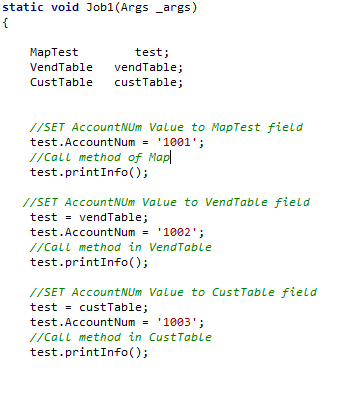Hi all,
Today I am going to tell you guys how to Import Data from an Excel file into Ax Table using a Dialog.
Step 1 : Create a Table (ProductType) with three fields as following :
Step 2: Create a class "ImportExcel" that extends Runbase framework and with the following methods :
class ImportExcel extends RunBase
{
#excel
#file
FileNameOpen fileNameOpen;
DialogField dialogfileNameOpen;
COMVariant comVariant1;
COMVariantType comVariant2;
SysExcelApplication app;
SysExcelWorkbooks workbooks;
SysExcelWorkbook workbook;
SysExcelWorksheets worksheets;
SysExcelWorksheet worksheet;
SysExcelCells cells;
SysExcelCell rcell;
#define.CurrentVersion(1)
#localMacro.CurrentList
fileNameOpen
#endMacro
}
public Object dialog()
{
DialogRunBase dialog = super();
;
dialog.caption("@SYS7444");
dialogfileNameOpen = dialog.addFieldValue(typeid(FileNameOpen), fileNameOpen);
dialog.filenameLookupFilter(["@SYS28576",#XLSX, "@SYS28576",#XLS]);
return dialog;
}
public boolean getFromDialog()
{
boolean ret;
ret = super();
fileNameOpen = dialogfileNameOpen.value();
return ret;
}
public container pack()
{
return [#CurrentVersion, #CurrentList];
}
public boolean unpack(container _packedClass)
{
Version version = RunBase::getVersion(_packedClass);
;
switch (version)
{
case(#CurrentVersion) :
[version, #CurrentList] = _packedClass;
break;
default :
return false;
}
return true;
}
public boolean validate(Object calledFrom)
{
boolean ret;
ret = super(calledFrom);
if(!fileNameOpen)
ret = checkFailed(strfmt('File name cannot be left blank'));
if(fileNameOpen && !WinApi::fileExists(fileNameOpen))
ret = checkfailed('File not found');
return ret;
}
public static void main(Args args)
{
ImportExcel importMapping;
;
importMapping = new ImportExcel();
if (importMapping.prompt())
{
importMapping.run();
}
}
public void run()
{
try
{
ttsbegin;
this.importExcel();
ttscommit;
}
catch (Exception::Error)
{
ttsabort;
exceptionTextFallThrough();//to avoid Compiler error
}
}
And finally the ImportExcel method of the class :
void importExcel()
{
#AviFiles
ProductType productType;
int row;
SysOperationProgress progress1;
;
//Define parameters
app = SysExcelApplication::construct();
Workbooks = app.Workbooks();
COMVariant1 = new COMVariant();
COMVariant1.bStr(fileNameOpen);
Workbook = Workbooks.add( COMVariant1);
Worksheets = Workbook.worksheets();
Worksheet = Worksheets.itemFromNum(1);
Cells = Worksheet.Cells();
progress1 = new SysOperationProgress();
progress1.setCaption("Excel import");
progress1.setAnimation(#AviTransfer);
delete_from productType ;
row = 1;
do
{
progress1.setText(strfmt("Importing row %1", row));
productType.ID = cells.item(row,1).value().bStr();
productType.Type = cells.item(row,2).value().bStr();
productType.Description = cells.item(row,3).value().bStr();
productType.insert();
row++;
COMVariant2 = cells.item(row, 1).value().variantType();
}
while( COMVariant2!= COMVariantType::VT_EMPTY);
info(strfmt("%1 rows imported", row-1));
}
Happy Daxing:)
Today I am going to tell you guys how to Import Data from an Excel file into Ax Table using a Dialog.
Step 1 : Create a Table (ProductType) with three fields as following :
Step 2: Create a class "ImportExcel" that extends Runbase framework and with the following methods :
class ImportExcel extends RunBase
{
#excel
#file
FileNameOpen fileNameOpen;
DialogField dialogfileNameOpen;
COMVariant comVariant1;
COMVariantType comVariant2;
SysExcelApplication app;
SysExcelWorkbooks workbooks;
SysExcelWorkbook workbook;
SysExcelWorksheets worksheets;
SysExcelWorksheet worksheet;
SysExcelCells cells;
SysExcelCell rcell;
#define.CurrentVersion(1)
#localMacro.CurrentList
fileNameOpen
#endMacro
}
public Object dialog()
{
DialogRunBase dialog = super();
;
dialog.caption("@SYS7444");
dialogfileNameOpen = dialog.addFieldValue(typeid(FileNameOpen), fileNameOpen);
dialog.filenameLookupFilter(["@SYS28576",#XLSX, "@SYS28576",#XLS]);
return dialog;
}
public boolean getFromDialog()
{
boolean ret;
ret = super();
fileNameOpen = dialogfileNameOpen.value();
return ret;
}
public container pack()
{
return [#CurrentVersion, #CurrentList];
}
public boolean unpack(container _packedClass)
{
Version version = RunBase::getVersion(_packedClass);
;
switch (version)
{
case(#CurrentVersion) :
[version, #CurrentList] = _packedClass;
break;
default :
return false;
}
return true;
}
public boolean validate(Object calledFrom)
{
boolean ret;
ret = super(calledFrom);
if(!fileNameOpen)
ret = checkFailed(strfmt('File name cannot be left blank'));
if(fileNameOpen && !WinApi::fileExists(fileNameOpen))
ret = checkfailed('File not found');
return ret;
}
public static void main(Args args)
{
ImportExcel importMapping;
;
importMapping = new ImportExcel();
if (importMapping.prompt())
{
importMapping.run();
}
}
public void run()
{
try
{
ttsbegin;
this.importExcel();
ttscommit;
}
catch (Exception::Error)
{
ttsabort;
exceptionTextFallThrough();//to avoid Compiler error
}
}
And finally the ImportExcel method of the class :
void importExcel()
{
#AviFiles
ProductType productType;
int row;
SysOperationProgress progress1;
;
//Define parameters
app = SysExcelApplication::construct();
Workbooks = app.Workbooks();
COMVariant1 = new COMVariant();
COMVariant1.bStr(fileNameOpen);
Workbook = Workbooks.add( COMVariant1);
Worksheets = Workbook.worksheets();
Worksheet = Worksheets.itemFromNum(1);
Cells = Worksheet.Cells();
progress1 = new SysOperationProgress();
progress1.setCaption("Excel import");
progress1.setAnimation(#AviTransfer);
delete_from productType ;
row = 1;
do
{
progress1.setText(strfmt("Importing row %1", row));
productType.ID = cells.item(row,1).value().bStr();
productType.Type = cells.item(row,2).value().bStr();
productType.Description = cells.item(row,3).value().bStr();
productType.insert();
row++;
COMVariant2 = cells.item(row, 1).value().variantType();
}
while( COMVariant2!= COMVariantType::VT_EMPTY);
info(strfmt("%1 rows imported", row-1));
}
Happy Daxing:)










